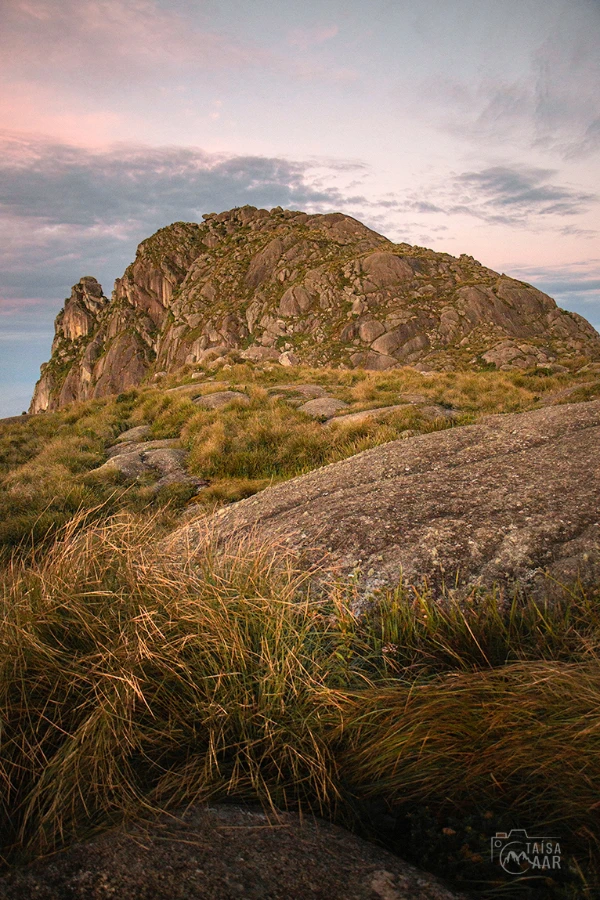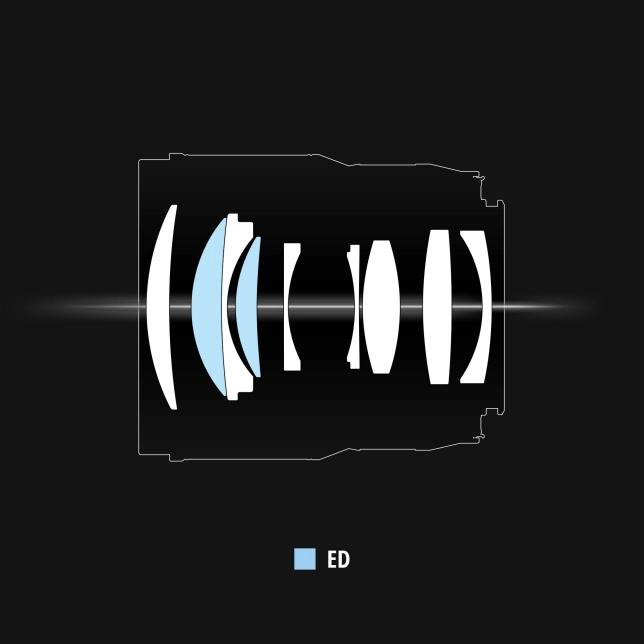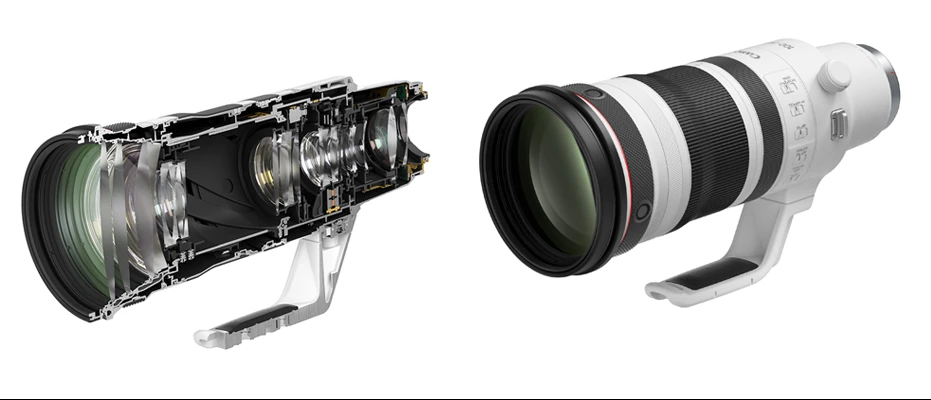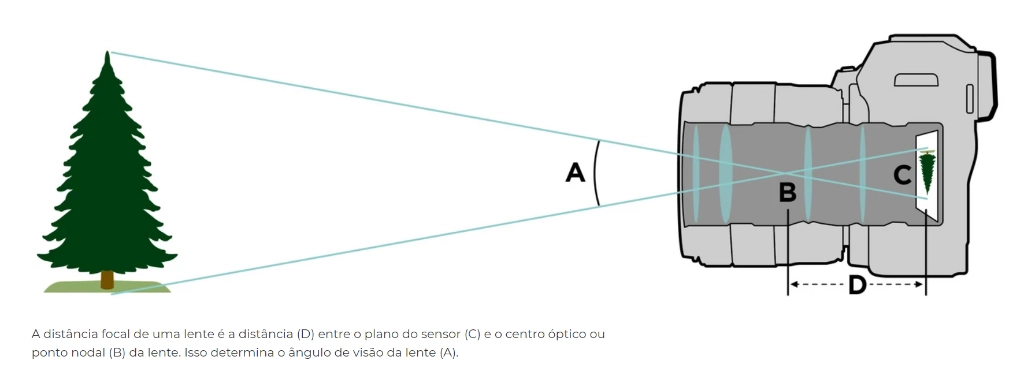At over 2,300 meters in altitude, surrounded by the mountains of the Serra da Mantiqueira, stands the imposing Pico do Itaguaré. Located on the border between Minas Gerais and São Paulo, this peak stands out for its rugged formation, with cracks that extend to the base and vegetation typical of high altitudes.
The details that shape this monolith, such as the cliffs and the shrubs that intertwine, are true natural wonders. When faced with such grandeur, it is almost instinctive to want to capture it in a photograph.
Some may consider Itaguaré just another peak among many, but for those who, like me, recognize the uniqueness of each mountain, the desire to photograph it is inevitable.

Pico do Itaguaré 18-135 Lens at 18mm f/3.5 1/320s ISO 400
To photograph a natural monument like Itaguaré, it is essential to have the right photographic equipment, one capable of accurately capturing the distinctive features of a mountain formation. However, contrary to what many may think, this equipment does not have to be a state-of-the-art camera or the most powerful model on the market.
Of course, a high-quality camera will produce more precise photos, but it does not do the work alone. If you have a basic camera, a good lens, and the willingness to capture, you already have the essentials for what we are about to discuss.
A good lens, in turn, does not have to be the most expensive or premium but rather the ideal one for what you want to photograph. In the case of Pico do Itaguaré, it is necessary to capture it from a distance to frame its full magnificence, but as you move further away, you may lose the sharpness needed to highlight its textures, shapes, and colors. The solution lies in choosing a lens with the ideal focal length between the optical center and the camera sensor.
Revealing, in a single image, the unique features of a mountain like Itaguaré requires a careful selection of the lens type, also known as an objective.
What is a photographic lens or objective?
A camera lens is an optical component responsible for focusing light rays from an object, scene, or person and projecting them, through refraction, onto the camera sensor, transforming them into an image, whether digital or analog. Mobile phones, reflex or mirrorless cameras, compact cameras, and action cameras all use lenses. Since its function is to direct the image inside the camera through light, we can say that without the lens, there is no photography.

Light beam passing through the inside of a photographic lens. Source: https://shop.panasonic.com/es/products/s-series-85mm-f1-8-l-mount-lens
Although there are ways to capture images without lenses, the process occurs differently. There is a device without a lens, for example, that creates images from external antennas that collect data, forming a visual representation that, while not exactly a photograph, resembles one. This device is known as Paragraphica. It has only the body of a camera, but instead of a lens, there is a data collection structure.

Paragraphica. Source: https://www.creativeapplications.net/objects/paragraphica-context-to-image-ai-camera/
The creators of Paragraphica themselves acknowledge that the images generated by it cannot be considered photographs since photography as a technique happens through light, not data. In traditional photographic processes, a lens focuses the light rays emitted by an object or scene and projects them inside the camera. Therefore, even though it is possible to create images without a lens, when it comes to photography, the lens remains indispensable.
The lens reveals a lot at the moment of the shot!
Sharpness vs. Lens
Sharpness in photography refers to the ability to capture details clearly and precisely, without blending or distortion. This attribute is essential for creating high-quality images, as the more defined the contours and the more delineated the elements in the photo, the greater the sharpness. In a sharp image, objects appear with precise lines and no blurring, enhancing both quality and aesthetics.
Several factors influence sharpness, including the lens used, camera settings, focus, and stability during capture. Some lenses come with motion stabilizers, which help eliminate shakes at the moment of the shot, preventing contours from overlapping in a misaligned way. The lens also performs focusing, which must be precise to ensure sharpness.
Most photographic lenses are made up of multiple glass elements, each designed with optical surfaces that serve specific purposes. These surfaces are engineered to maximize image quality by controlling how light enters the lens, passes through the elements, and reaches the sensor or film. The curved surfaces of the lens allow light to change direction as it passes through, which is essential for focusing light to a specific point and forming a sharp image.
Additionally, the optical surfaces are designed to reduce aberrations, such as chromatic aberration, which causes color focus discrepancies, and spherical aberration, which results in blurring around the edges. This ensures more accurate and less distorted images. Many anti-reflective or multi-coated layers applied to the surfaces also help minimize unwanted reflections, increasing contrast, color fidelity, and therefore, sharpness.
Since the lens is responsible for directing and focusing the light that forms the image, the quality of the internal lens elements — such as their optical surfaces and alignment — determines how effectively the light is manipulated, directly impacting image sharpness. Therefore, choosing a well-constructed lens is essential for capturing great photographs.
Lens Elements
See in the following image the multiple glass elements that make up the interior of a telephoto or zoom lens. Each of these elements is an optical surface that plays a specific role.

Source: https://www.canon.com.br/para-voce/lentes-e-outros/lentes-rf/rf-100-300mm-f/28-l-is-usm
These glass elements are responsible for focusing light and forming the image. Each element has optical surfaces that serve specific functions. The type of glass and the coatings applied to the surfaces can affect how much light passes through the lens. This is where terms like “bright” or “fast” lens and “dark” lens come from.
In photography, a lens is considered “dark” when the light entry diameter is small. In addition, depending on the lens construction, its internal elements — such as the glass itself — may not be of the best quality to transmit all the light to the camera’s sensor or film.
Depending on the shape of the internal glass elements, some optical aberrations may appear in the photo, such as spherical and chromatic aberrations. Spherical lenses, with rounded surfaces, tend to bend light rays in a way that they do not meet on the same focal plane, which can cause the image to appear blurry or less sharp, especially at the edges.
Each well-aligned and well-constructed optical surface will maximize image quality by controlling how light enters the lens, passes through its elements, and reaches the sensor or film. So, the quality of the internal lens elements determines how effectively light is manipulated and, consequently, how sharp the image will be.
Therefore, the lens not only focuses the image, but also defines its clarity, accuracy, and detail fidelity. A high-quality lens helps capture sharp images even in challenging conditions, while low-quality lenses may introduce imperfections that compromise sharpness.
One interesting fact about lens shape is that they are built with spherical construction to allow light to be collected more efficiently from all directions. Moreover, the tubular shape of lenses is the most practical to handle and the cheapest to manufacture. However, it is possible to invest in a reasonably priced lens and still get good quality to ensure your best shots!
Focal Length
Depending on the lens, a photograph can capture details that are very close to what our eyes see. This depends on the lens’s focal length — a concept also known as focal distance — which is the measurement from the optical center of the lens to the camera sensor.

Source: https://www.canon.ge/pro/infobank/understanding-focal-length/. Freely translated
Each lens has a focal length, and this measurement — given in millimeters — defines the field of view for a frame, in other words, how much of the scene the lens can capture. Depending on the focal length, scenes can be wide with a 180-degree field of view or narrower with angles of less than 10 degrees.
It’s interesting to note that a lens with a focal length around 43mm reflects into the camera an image similar to what the human eyes can see, as studies suggest the human eye’s focal length is close to 43mm.
Although the eyes share some similarities with a lens, human vision has its limitations. For starters, the retina is not flat like a camera sensor. Also, our eyes cannot zoom to the horizon or bring distant objects closer like telephoto lenses, nor can they magnify microscopic details like macro lenses do.
The shorter the focal length, the wider the angle of view, and the more wide-angle the lens is. The longer the focal length, the narrower the angle of view, and the more telephoto the lens becomes. Wide-angle and telephoto are two types of lenses, just like a macro lens.
Finally, focal length also plays an important role in sharpness. So, a lens not only influences focus and stability but should also be chosen carefully according to its focal length.
Now that we understand the importance of lenses in photography, we can dive deeper into the topic in future posts. For now, feel free to continue the conversation in the comments.
See you next time, folks!
This post is also available in: Português (Portuguese (Brazil)) Español (Spanish)
